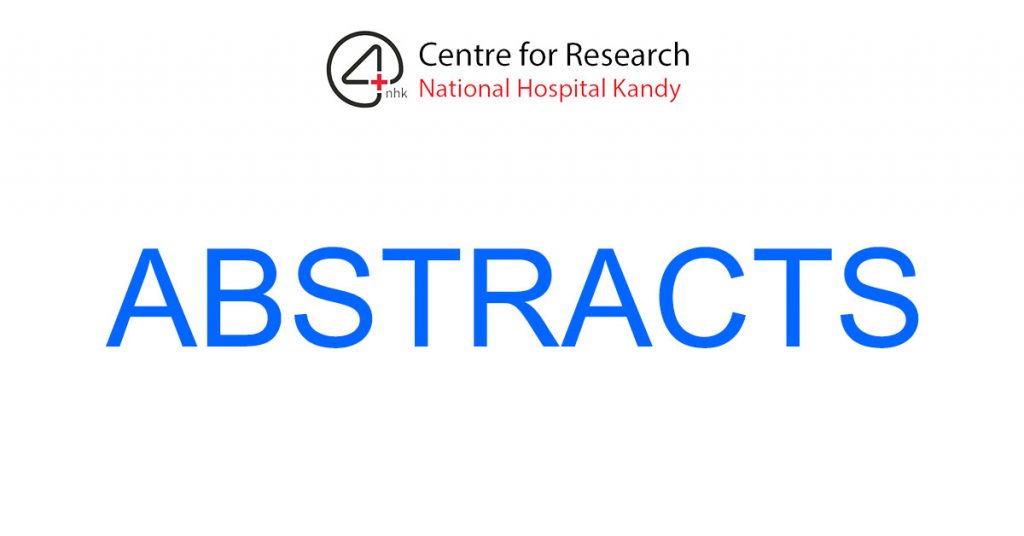USE OF THIOBARBITURIC ACID REACTIVE SUBSTANCES AND TOTAL ANTIOXIDANT CAPACITY AS POTENTIAL EARLY MARKERS OF ACUTE CORONARY SYNDROMES
Weerakoon.S.W.M.P.W.C.I.B1, Udaya Ralapanawa2, Yatawara. M.D.M.L.D.K3 and Sivakanesan.R.4
- Department of Medical Laboratory Science, Faculty of Allied Health Sciences,
University of Peradeniya - Professor in Medicine, Department of Medicine, Faculty of Medicine, University of Peradeniya
- Professor, Department of Medical Laboratory Science, Faculty of Allied Health Sciences,
University of Peradeniya - Professor Emeritus, Faculty of Medicine, University of Peradeniya
ABSTRACT
Background: Acute Coronary Syndrome (ACS) is a term used to address the spectrum of disease conditions including STEMI, UA, and NSTEMI. Biomarkers as indicators of normal physiology and pathological conditions play a vital role in the diagnosis of ACS and its related events.
Objectives: This study was designed to evaluate the utility of TBARS and TAC parameters in predicting ACS, excluding non- ACS cases from patients with chest pain, and categorization of ACS into its subtypes.
Methods: In this analytical cross-sectional study, serum concentrations of both parameters were measured in a total of 81 participants including 51 patients with clinically diagnosed ACS and 30 healthy individuals. TBARS was measured as MDA concentration by a method developed by Niehaus JR. and Samuelsson (1968). TAC was estimated by a method of Benzie and Strain (1999). Ethical clearance for this study was granted by the Ethics Review Committee of the Faculty of Allied Health Sciences, University of Peradeniya.
Results: TBARS and TAC were significantly different [P= 0.0000*(P<0.001)] in the ACS patients when compared to the controls. When compared pairwise, the median of TBARS concentration of the patients found to be significantly higher than (P values, PSTEMI=0.000068, PNSTEMI=0.000024, and PUA=0.006) the controls, but there were no significant differences (P>0.05) among the subtypes of ACS. Median TBARS values increased in the pattern of STEMI< NSTEMI< UA. Sensitivity, Specificity, PPV, and NPV of the TBARS assay were 88%, 66.67%, 81.48%, and 76.92%. When TAC was compared pairwise, only the mean of UA showed distinguishable difference (P=0.021) over the controls. There were no significant differences (P>0.05) among the subtypes of ACS in TAC. Mean TAC values increased in the pattern of UA < STEMI < NSTEMI < Controls. Sensitivity and the specificity of TAC assay were 68% and 66.67%.
Conclusions: Based on the present study results it can be concluded that TBARS and TAC parameters have greater utility in excluding non-ACS patients from a population of patients with chest pain. Both the parameters can be utilized for differentiating UA cases from the controls. TBARS can also be used to distinguish all three subtypes of ACS from the healthy population. These parameters cannot be used in the differentiation of ACS groups.
Abbreviations: STEMI=ST-elevation myocardial infarction, UA=Unstable Angina, NSTEMI=Non-ST elevation myocardial infarction, PPV=positive predictive value, NPV=negative predictive value, PSTEMI = P value for Control vs.STEMI, PNSTEMI= P value for Control vs.NSTEMI, PUA= P value for Control vs.UA
![]()




